Samsung Galaxy Note 10.1 (2014 Edition) Review: Wi-Fi Vs. LTE
Today's review of Samsung's Galaxy Note 10.1 (2014 Edition) includes the LTE-capable and Wi-Fi-only tablets, allowing us to compare Samsung's own Exynos 5 Octa platform to Qualcomm's Snapdragon 800. Can either configuration usurp Apple's iPad Air?
Why you can trust Tom's Hardware
Look And Feel
Samsung chose the design used in its smaller Galaxy Note 3 to help unify the family's look. Gone are the glossy backs of previous Galaxy tablets. Instead, we have the faux-leather, plastic-molded back—fake stitching and all. Similar to the Note 3, this is a huge improvement over the HyperGlaze finish of previous Galaxy devices.

Drawing additional inspiration from the phablet, Samsung's Note 10.1 2014 sports the same ridged, faux-metal sides, which somewhat resemble the pages of a closed book.

As with any tablet, the device's weight and thickness are of utmost importance. At 540 grams (1.2 pounds) and 7.9 mm (0.3 inches) thick, the Note 10.1 (2014 Edition) Wi-Fi is a fairly slim, light package that's great for content consumption.
The iPad Air, in comparison, is a meager 469 grams (1.03 pounds) for the Wi-Fi version and 478 grams (1.05 pounds) for the LTE version. Both are a slender 7.5 mm (0.3 inches) thin.
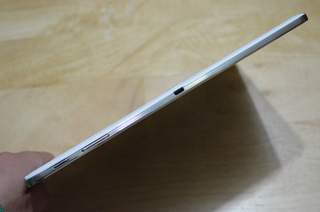
On the top of the Galaxy, you find a power button and volume rocker toward the left edge, along with an IR Blaster in the center.

As with most Android tablets, the Note 10.1 is designed for use in landscape mode. Bezels are thinner on the sides than on the top and bottom. That's a bit odd; if you have wider thumbs, it becomes easier to mistakenly trigger the touch screen. The 16:10 aspect ratio makes it awkward to use the Note 10.1 2014 in portrait mode.
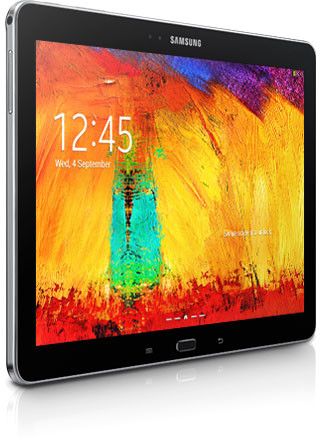
One of the stereo speakers and a 3.5-mm headset jack occupy the left side, transitioning from front-firing drivers to less-than-ideal side-firing speakers. But we'll have more on that later in the review.
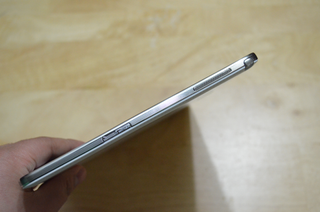
The right side of the Galaxy Note 10.1 holds the S Pen dock, the other stereo speaker and the microSD card slot.
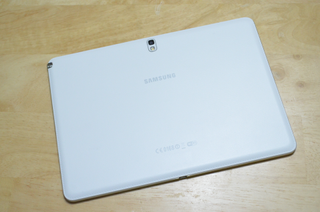
The faux-leather back dominates the device's back side, and is surrounded by faux stitching. Samsung's branding is also back there, along with an 8-megapixel camera and an LED flash.
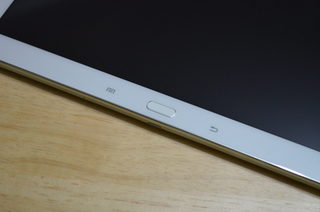
The bottom of the unit hosts a pinhole mic and a micro-USB port, which doubles as the power plug.
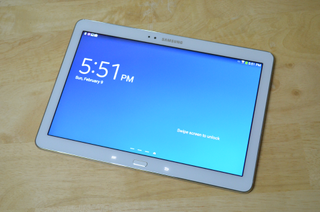
While we personally prefer the 7- to 8-inch form factor, enthusiasts looking for a 10-inch Android-powered tablet will have a hard time finding something thinner or lighter than the 540-gram (1.19 pounds) Note 10.1 (2014 Edition) Wi-Fi or 547-gram (1.20 pounds) Note 10.1 (2014 Edition) LTE. Then again, if mobility is of primary importance to you, and you're not averse to iOS, you might prefer the lighter 469-gram (1.03 pounds) iPad Air.
In the end, we're pretty happy with the Note 10.1 2014's overall build, and its looks are more refined than previous Galaxy tablets'. Although the bezels could use some refinement, the fact that the Note is thinner and lighter than a lot of other Android tablets makes it easier to handle over prolonged periods.
Current page: Look And Feel
Prev Page Samsung's S Pen Attack On The Full-Size Tablet Market Next Page Camera, Display, And SpeakersStay On the Cutting Edge: Get the Tom's Hardware Newsletter
Join the experts who read Tom's Hardware for the inside track on enthusiast PC tech news — and have for over 25 years. We'll send breaking news and in-depth reviews of CPUs, GPUs, AI, maker hardware and more straight to your inbox.
-
blackmagnum The only possible way Samsung mobile devices can be a worthwhile alternative to Apple is when they ditch the every-man Android and create their own tightly controlled/ managed OS like Apple. Do that and consumers might not feel like they're just buying the Samsung for the hardware.Reply -
Farrwalker On page 7. Results: CPU Core Benchmarks:Reply
Your bar graph "MobileXPRT 2013" seems to be in error.
For example, the text says, "Note 10.1 (2014 Edition) Wi-Fi leads with 300 points . . ."
but the bar is the shortest and indicates less than 150 points.
-
blueer03 You need to proofread this big time. From page 9:Reply
Samsung's Exynos-based Note 10.1 (2014 Edition) Wi-Fi holds its own against the Tegra Note 7, while the LTE version of the Note 10.1 (2014 Edition) again falls significantly behind its Snapdragon 800-powered Wi-Fi counterpart.
And this happens all throughout. The LTE is a Snapdragon, the Wifi is an Exynos. Keep repeating that to yourself as you re-write the descriptions and it will make this easier to read. -
Kevin Harrelson We got one of these for my son (age 13) to help with his school work. We got it from Best Buy and got the extended warranty. Both sound dumb, but it was actually a good move! The backlight has gone out on this thing TWICE. I happen to think that it is a lovely little tablet, but the backlight is a major reliability issue.Reply -
adamovera ReplyOn page 7. Results: CPU Core Benchmarks:
This benchmark's sub-tests produce scores in seconds (lower is better), and the overall score is given as a typical higher-is-better score, so the lowest bar indicates the fastest completion. Sorry about the confusion, I'll look into other ways to represent this test.
Your bar graph "MobileXPRT 2013" seems to be in error. For example, the text says, "Note 10.1 (2014 Edition) Wi-Fi leads with 300 points . . ." but the bar is the shortest and indicates less than 150 points.
-
adamovera ReplyYou need to proofread this big time. From page 9:
Good catch, thanks! Fixed.
Samsung's Exynos-based Note 10.1 (2014 Edition) Wi-Fi holds its own against the Tegra Note 7, while the LTE version of the Note 10.1 (2014 Edition) again falls significantly behind its Snapdragon 800-powered Wi-Fi counterpart.
And this happens all throughout. The LTE is a Snapdragon, the Wifi is an Exynos. Keep repeating that to yourself as you re-write the descriptions and it will make this easier to read. -
Tomtompiper The 2014 is almost 5 months old and has been superseded by the Amoled screened Galaxy Tab S 10.1 which wipes the floor with the opposition. http://www.gsmarena.com/samsung_galaxy_tab_s_105-review-1097.php Do try to keep up!Reply -
adamovera ReplyThe 2014 is almost 5 months old and has been superseded by the Amoled screened Galaxy Tab S 10.1 which wipes the floor with the opposition. http://www.gsmarena.com/samsung_galaxy_tab_s_105-review-1097.php Do try to keep up!
Actually, you'd think this has been phased out, but it's the current 10-inch Galaxy "Note" product, meaning it has the S Pen. The Galaxy "Tab" S does not - still unclear to me what makes the "S" stand out. I believe Samsung is literally attempting to offer an alternative product to every single other device in existence - complete mobile domination. I lost count of their current "Galaxy" line at 11 products, and that was awhile back.
The duo of Note 10.1 (2014)'s came in very handy both as comparison data in other articles and as testbeds for compiling our benchmark suite. Unfortunately, the article had to be pushed back several times, but the huge hardware difference between products carrying the same name was always something we wanted to illustrate, initially for the chipset-vs-chipset angle, but later for the optimization aspect as well. We're currently working through a small backlog of mobility articles, but each will be more timely than the last. My apologies. -
Blazer1985 I really wish Samsung could help the end user distinguish what they are buying. The 2 Note are classified as "LTE" and "WIFI ONLY" which sounds like 2 equal devices except for the sim card slot while they actually have a totally different soc.Reply -
vaughn2k ... and Samsung prices are now on par with Apple's. others are okay. Will wait for Asus and other competition. Should be cheaper though...Reply
